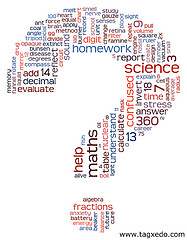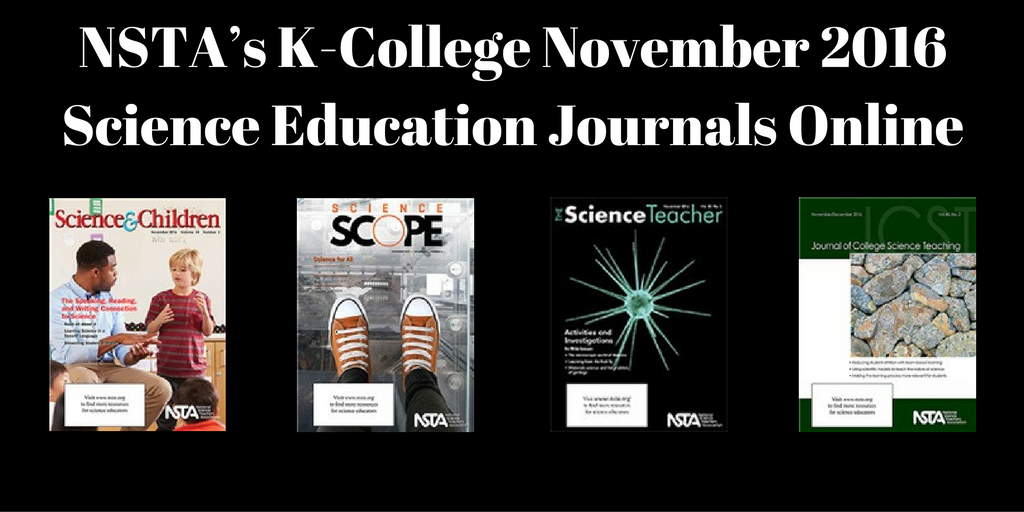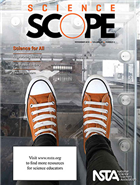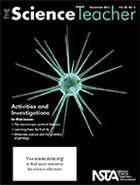When Rogue One: A Star Wars Story debuts next month, science teachers who use the Star Wars films in their classrooms will have another tool not just for teaching science, but also for integrating it with other subjects. The films “are a great place to integrate science and the arts,” says Jacob Clark Blickenstaff, NSTA’s media reviewer and Director of K–12 Engagement at the Pacific Science Center in Seattle. “If teachers are worried about STEM (science, technology, engineering, and math) leaving out the arts, [the films] are a great place to make that connection.”

John Derian uses Star Wars films in his Living Environment and Physical Science class at The Brooklyn International High School in New York City. Here students are doing a peer tutoring activity about protein synthesis using magnetic nucleotides to build DNA and mRNA. (photo by John Derian)
John Derian, who teaches ninth- and 10th-grade Living Environment and Physical Science to newly arrived immigrants at The Brooklyn International High School in New York City, uses the first three Star Wars films to do just that. After learning sculpting from an art teacher, he incorporated it in a Star Wars project-based unit he created for a school-wide interdisciplinary portfolio project with the theme “Adaptation”: something young immigrants can readily relate to.
Working in groups, “students design and sculpt an alien animal adapted to a specific Star Wars planet and identify its unique sequence of DNA by investigating ecology of different ecosystems, animal adaptations, and protein synthesis,” Derian explains.
“Students model their animals around real animals and adaptations…We look at animal skeletons” to prepare them to create their alien animal’s framework, he relates. Students “look at the Star Wars animals with a critical eye [and ask the] big questions, such as, ‘Did [George] Lucas consider adaptations when he created [those animals]?’”
In addition to completing written assignments, students create time-lapse videos showing the creation of their alien animal. Derian says he asks students to do this “to be more cognizant of the design process in the moment. Additionally, the requirements for the final fully edited time-lapse video require students to reflect on the design process and how they collaborated together.”
Because the protein synthesis of real animals involves sequences of 50 to 1,000 amino acids, Derian does short sequences with the alien animals instead. “I’ve never had students more enthusiastic about learning protein synthesis,” he asserts. Using their Star Wars animal “makes [it] more purposeful.”
“Darth Maker”—a.k.a. Dave Marriott, makerspace lab facilitator at Stateside Elementary School in Jacksonville, North Carolina—incorporates Star Wars in subjects like robotics to provide students with authentic experiences for applying science and math. “I show students the clip from Episode IV [in which] Luke is buying droids. [Then I ask,] ‘What is their purpose?’” says Marriott.
“We’ll have a discussion: Could we have a lightsaber or autonomous droids? Or I’ll show the clip from Episode II with C-3PO, a droid, making other droids. Then I’ll show a video of robots building cars, assembly-line robots, so [students] can see how they’re used in society,” he relates.
“Kids want to build what they see,” Marriott contends. When they build robots, they “see where science fiction turns into reality, even if their robot
looks more C-3PO than I’d like.”
May the Force Game With You
Amy Alexander, science teacher at Angola High School in Angola, Indiana, uses Star Wars to teach evolution and created an activity with a gaming element. “[S]tudents [read] a page from Star Wars: The Essential Guide to Alien Species, which describes the characteristics of dianogas, the slithering, one-eyed creatures who live in the garbage chutes of spaceships. I show students the clip from Episode IV [in which] Han, Luke, Leia, and Chewie escape down the chute, and Luke gets pulled under by the dianoga.”
Next, “students roll dice to determine how the next generation of dianoga will evolve. They then get to decide the path of evolution, and roll a die to determine what type of environmental change will occur. They then make a determination as to whether the new trait will be beneficial in this new environment or not.
“They go through this cycle 4–5 times and draw their final dianoga in its new environment. This really gives students a chance to be super creative,” she contends.
Megan Menker, middle division teacher at Marburn Academy in Columbus, Ohio, incorporated Star Wars in her grades 7–8 physics unit to teach about forces, vector diagrams, and net force. In one game-like activity, she gave each student a paper lightsaber with an amount of Newtons specified on it. “They took their lightsabers up to the blackboard for a duel and drew vector diagrams demonstrating the force of their lightsabers,” she relates. “They then determined who is stronger by subtracting the difference between the forces to find the net force.”
Then as a class, “we combined forces to overcome Darth Maul, and drew vector diagrams to represent that. By themselves, each Jedi was not strong enough…The students realized they had to combine forces to beat Darth Maul,” she points out.
Attacking Science Flaws
Some educators have their students explore the films’ scientific inaccuracies. In her sound unit for preservice teachers, Mary Lamar, science manager and chemistry lecturer at Eastern Kentucky University in Richmond, Kentucky, has students “write a letter to George Lucas to explain why they would not hear the Death Star explosion in space if they were [in] X-Wing fighter[s] with their back[s] to the Death Star and the communications system [was] down.”
After her eighth graders complete a unit on force, energy, and motion, Rebecca Kern, Year 2 and 3 Integrated Science Educator at Channing Hall International Baccalaureate World School in Draper, Utah, shows her students a Star Wars film. “While viewing [it], students take notes about all of the ‘misuses’ of physics” in it, she notes. When the film ends, “students immediately start writing an argumentative essay that includes topics such as Newton’s Laws of Motion, lightsabers, sound in space, jet engines, and explosions in space. I also give the students links to supplemental materials, such as Discovery Channel’s MythBusters episodes on Star Wars…, that they can use as evidence to back up their claims” in the essay, Kern explains.
Theresa Jones, science teacher at Hackensack Middle School in Hackensack, New Jersey, shows her fifth graders Episode IV. They then “brainstorm all the science fiction in the film” and create a list of topics for a research paper, says Jones. Their papers include “what the real-world equivalent technology/invention would be”and “the scientific principles involved in making it a reality,” as well as the benefits and negative effects of it, she relates.
“Kids typically like doing the research paper because they really want to know if these crazy things just might be possible,” Jones contends.
This article originally appeared in the November 2016 issue of NSTA Reports, the member newspaper of the National Science Teachers Association. Each month, NSTA members receive NSTA Reports, featuring news on science education, the association, and more. Not a member? Learn how NSTA can help you become the best science teacher you can be.
The mission of NSTA is to promote excellence and innovation in science teaching and learning for all.
Follow NSTA




 Dr. David L. Evans is the Executive Director of the National Science Teachers Association (
Dr. David L. Evans is the Executive Director of the National Science Teachers Association (







 Flying across the country to the conference for the National Association for the Education of Young Children brought many different landscapes into view through the plane window. I saw ridges, meandering rivers and river-carved canyons, heavily wooded areas, hills, mirror-like lakes, flat regions that went on and on, and sharp snow covered peaks. Human impact on the land appeared as long straight and curved lines, circles, crazy quilt patches, and structures of many shapes including skyscrapers, railway lines, wind turbines, flat roofs, single structures and clusters of structures. The sky changed from clear to cloudy.
Flying across the country to the conference for the National Association for the Education of Young Children brought many different landscapes into view through the plane window. I saw ridges, meandering rivers and river-carved canyons, heavily wooded areas, hills, mirror-like lakes, flat regions that went on and on, and sharp snow covered peaks. Human impact on the land appeared as long straight and curved lines, circles, crazy quilt patches, and structures of many shapes including skyscrapers, railway lines, wind turbines, flat roofs, single structures and clusters of structures. The sky changed from clear to cloudy. We can begin with becoming very familiar with the area around our own school or home, talking about its slopes, vegetation, and structures. Help children take an inventory of the natural features of their play area counting how many: trees or other plants, rocky areas, puddles, grass lawns, mulched areas, steep slopes and gentle inclines, and other elements. An inventory can include human structures such as fences, tables, and climbing structures. As they count and record how many, children can sort the features into groups, natural or human-made. Ask children what elements they would add, if possible.
We can begin with becoming very familiar with the area around our own school or home, talking about its slopes, vegetation, and structures. Help children take an inventory of the natural features of their play area counting how many: trees or other plants, rocky areas, puddles, grass lawns, mulched areas, steep slopes and gentle inclines, and other elements. An inventory can include human structures such as fences, tables, and climbing structures. As they count and record how many, children can sort the features into groups, natural or human-made. Ask children what elements they would add, if possible. At the beginning of class, it takes my students a long time to settle down. We are wasting time as I try to get their attention. Any suggestions? –T., Maryland
At the beginning of class, it takes my students a long time to settle down. We are wasting time as I try to get their attention. Any suggestions? –T., Maryland